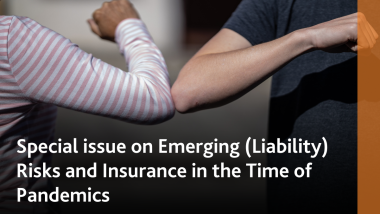Physical climate risks associated with extreme weather events are increasing due to climate change. The past seven years are on track to be the seven warmest on record,[1] and more severe, more frequent extreme events are unfortunately becoming the new norm. The physical climate risks being amplified by this trend are a significant threat to societal resilience and a call for concerted efforts to step up mitigation measures. The first 2022 issue of The Geneva Papers on Risk and Insurance, edited by Christophe Courbage and Maryam Golnaraghi, examines the role insurance can play in managing these risks.
Are insurers aware of the problem?
In Awareness of climate risks and opportunities: empirical evidence on determinants and value from the U.S. and European insurance industry, Nadine Gatzert and Philipp Reichel analyse the extent to which insurers are alert to the risks and opportunities associated with climate change. From their sample of more than 50 insurers in Europe and the U.S., they find that larger European property & casualty insurers exhibit higher levels of awareness. Encouragingly, they also find that the proportion of insurers considering climate-related risks has increased from less than one half to over two thirds during the 10-year sample period (2009–2018), and that the management of climate change-related risks and opportunities has a significantly positive impact on firm value.
Promoting insurance take-up to improve resilience
Despite the relative abundance of insurance products for flood risk, demand often remains low. Increasing uptake would thus improve societal resilience to this growing risk. Peter John Robinson and W. J. Wouter Botzen investigate whether providing homeowners with information on the flood insurance purchasing decisions of their neighbours affects their own choices in Setting descriptive norm nudges to promote demand for insurance against increasing climate change risk. The effectiveness of the social norm nudges are found to be dependent on homeowners’ prior beliefs: those who show high levels of trust in insurance agents and low confidence in public flood defences are most likely to be influenced.
How effective are public-private insurance schemes?
In many countries, public-private insurance schemes have been developed to help bolster resilience to natural catastrophes. The French system, adopted in 1982, introduced a moderate, flat rate for premiums to tackle issues around affordability for lower-income groups – who often lived in areas at higher risk of flooding due to the associated lower cost of housing. In Insurance against natural catastrophes: balancing actuarial fairness and social solidarity, Arthur Charpentier, Laurence Barry and Molly R. James explore how the principles of this scheme are being challenged by climate change. As increasing risk levels of properties in wealthier coastal areas mean that higher socio-economic groups may become the main beneficiaries of a scheme originally designed to protect the worst-off, they argue that the introduction of some level of risk-based pricing may be necessary.
In Japan, the government-funded, post-disaster relief currently provided puts a considerable burden on the fiscal budget but the amount provided to affected households is viewed as insufficient. As flood insurance premiums in Japan are only partially risk-based, the market for private flood insurance is also limited due to large potential losses. In an attempt to identify a more effective solution, Jie Shao examines different approaches to public-private partnerships (PPPs) in Model assessment of public–private partnership flood insurance systems: an empirical study of Japan. Though a market-oriented PPP such as the U.K.’s Flood Re is found to be the most affordable option, integrating flood insurance into the well-functioning system for earthquake insurance is recommended as an adequate solution.
Reinsurance and catastrophe bonds as risk-transfer tools
Greater exposure to natural catastrophes due to climate change will also drive up insurers’ losses. The final three papers in the issue explore the use of reinsurance and catastrophe (CAT) bonds among insurance companies to soften potential financial blows.
In Exposure to catastrophe risk and use of reinsurance: an empirical evaluation for the U.S., Alejandro Drexler and Richard Rosen examine the extent to which catastrophe risk drives reinsurance usage. They find a positive correlation between exposure to catastrophe risk and the use of reinsurance overall, and further analysis reveals this is due to an increase in the use of non-proportional reinsurance specifically (where the proportion of losses covered by the reinsurer rises with those experienced by the insurer). No such relationship is found for quota reinsurance, where the reinsurer covers a proportion of losses equal to the premiums transferred.
In addition to reinsurance, insurers also use CAT bonds as part of their risk management strategies. Tobias Götze and Marc Gürtler look at what influences insurers’ choice between the two in Risk transfer beyond reinsurance: the added value of CAT bonds. Their findings show that CAT bonds provide added value to the risk management strategies of insurers that face a high risk of reinsurer default, that they are used as substitutes for reinsurance in high-risk layers, and that insurers with low exposure to basis risk replace reinsurance with non-indemnity CAT bonds.
Understanding the factors that affect the pricing of CAT bonds is important in view of their increasing relevance as an asset class for insurers. In Pricing dynamics in the market for catastrophe bonds, Peter Carayannopoulos, Olga Kanj and M. Fabricio Perez analyse the trend over time. Major catastrophes and associated CAT bond losses are found to increase the price of expected loss risk, which the authors posit is due to changes in investors’ effective risk aversion initiated by the attainment of habit consumption levels post-disaster. This is in contrast to previous theories, which suggest that the effect is a byproduct of behavioural changes in investor perceptions of catastrophic risk.
References
[1] World Meteorological Organisation. 2021. State of Climate in 2021: Extreme events and major impacts. https://public.wmo.int/en/media/press-release/state-of-climate-2021-extreme-events-and-major-impacts








